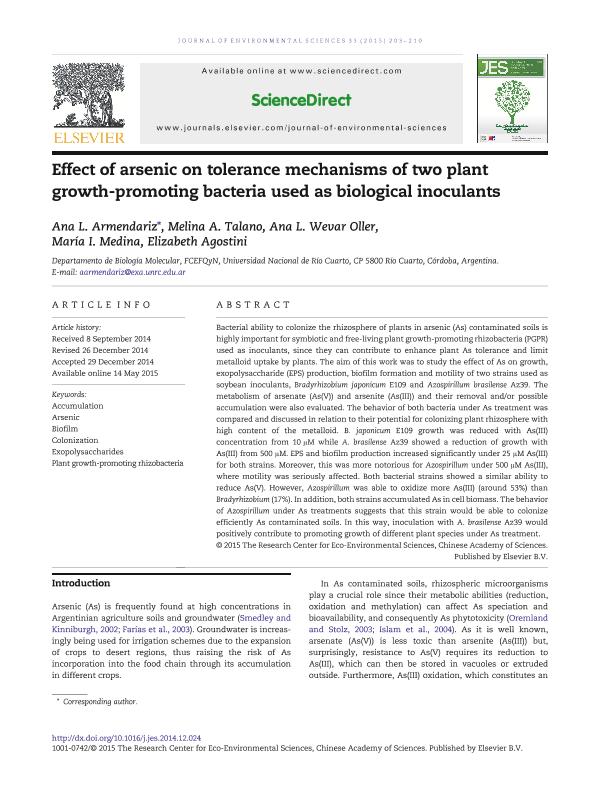Mostrar el registro sencillo del ítem
dc.contributor.author
Armendariz, Ana Laura

dc.contributor.author
Talano, Melina Andrea

dc.contributor.author
Wevar Oller, Ana Laura

dc.contributor.author
Medina, Maria Ines

dc.contributor.author
Agostini, Elizabeth

dc.date.available
2018-10-05T17:44:11Z
dc.date.issued
2015-07
dc.identifier.citation
Armendariz, Ana Laura; Talano, Melina Andrea; Wevar Oller, Ana Laura; Medina, Maria Ines; Agostini, Elizabeth; Effect of arsenic on tolerance mechanisms of two plant growth-promoting bacteria used as biological inoculants; Science Press; Journal of Environmental Sciences; 33; 7-2015; 203-210
dc.identifier.issn
1001-0742
dc.identifier.uri
http://hdl.handle.net/11336/61781
dc.description.abstract
Bacterial ability to colonize the rhizosphere of plants in arsenic (As) contaminated soils is highly important for symbiotic and free-living plant growth-promoting rhizobacteria (PGPR) used as inoculants, since they can contribute to enhance plant As tolerance and limit metalloid uptake by plants. The aim of this work was to study the effect of As on growth, exopolysaccharide (EPS) production, biofilm formation and motility of two strains used as soybean inoculants, Bradyrhizobium japonicum E109 and Azospirillum brasilense Az39. The metabolism of arsenate (As(V)) and arsenite (As(III)) and their removal and/or possible accumulation were also evaluated. The behavior of both bacteria under As treatment was compared and discussed in relation to their potential for colonizing plant rhizosphere with high content of the metalloid. B. japonicum E109 growth was reduced with As(III) concentration from 10. μM while A. brasilense Az39 showed a reduction of growth with As(III) from 500. μM. EPS and biofilm production increased significantly under 25. μM As(III) for both strains. Moreover, this was more notorious for Azospirillum under 500. μM As(III), where motility was seriously affected. Both bacterial strains showed a similar ability to reduce As(V). However, Azospirillum was able to oxidize more As(III) (around 53%) than Bradyrhizobium (17%). In addition, both strains accumulated As in cell biomass. The behavior of Azospirillum under As treatments suggests that this strain would be able to colonize efficiently As contaminated soils. In this way, inoculation with A. brasilense Az39 would positively contribute to promoting growth of different plant species under As treatment.
dc.format
application/pdf
dc.language.iso
eng
dc.publisher
Science Press

dc.rights
info:eu-repo/semantics/openAccess
dc.rights.uri
https://creativecommons.org/licenses/by-nc-sa/2.5/ar/
dc.subject
ACCUMULATION
dc.subject
ARSENIC
dc.subject
BIOFILM
dc.subject
COLONIZATION
dc.subject
EXOPOLYSACCHARIDES
dc.subject
PLANT GROWTH-PROMOTING RHIZOBACTERIA
dc.subject.classification
Meteorología y Ciencias Atmosféricas

dc.subject.classification
Ciencias de la Tierra y relacionadas con el Medio Ambiente

dc.subject.classification
CIENCIAS NATURALES Y EXACTAS

dc.title
Effect of arsenic on tolerance mechanisms of two plant growth-promoting bacteria used as biological inoculants
dc.type
info:eu-repo/semantics/article
dc.type
info:ar-repo/semantics/artículo
dc.type
info:eu-repo/semantics/publishedVersion
dc.date.updated
2018-10-01T15:44:33Z
dc.journal.volume
33
dc.journal.pagination
203-210
dc.journal.pais
China

dc.description.fil
Fil: Armendariz, Ana Laura. Universidad Nacional de Río Cuarto. Facultad de Ciencias Exactas Fisicoquímicas y Naturales. Departamento de Biología Molecular; Argentina. Consejo Nacional de Investigaciones Científicas y Técnicas; Argentina
dc.description.fil
Fil: Talano, Melina Andrea. Universidad Nacional de Río Cuarto. Facultad de Ciencias Exactas, Fisicoquímicas y Naturales. Departamento de Biología Molecular. Sección Química Biológica; Argentina. Consejo Nacional de Investigaciones Científicas y Técnicas; Argentina
dc.description.fil
Fil: Wevar Oller, Ana Laura. Universidad Nacional de Río Cuarto. Facultad de Ciencias Exactas, Fisicoquímicas y Naturales. Departamento de Biología Molecular. Sección Química Biológica; Argentina. Universidad Nacional de Río Cuarto. Facultad de Ciencias Exactas Fisicoquímicas y Naturales. Departamento de Biología Molecular; Argentina. Consejo Nacional de Investigaciones Científicas y Técnicas; Argentina
dc.description.fil
Fil: Medina, Maria Ines. Universidad Nacional de Río Cuarto. Facultad de Ciencias Exactas Fisicoquímicas y Naturales. Departamento de Biología Molecular; Argentina
dc.description.fil
Fil: Agostini, Elizabeth. Consejo Nacional de Investigaciones Científicas y Técnicas; Argentina. Universidad Nacional de Río Cuarto. Facultad de Ciencias Exactas Fisicoquímicas y Naturales. Departamento de Biología Molecular; Argentina. Universidad Nacional de Río Cuarto; Argentina
dc.journal.title
Journal of Environmental Sciences

dc.relation.alternativeid
info:eu-repo/semantics/altIdentifier/doi/http://dx.doi.org/10.1016/j.jes.2014.12.024
dc.relation.alternativeid
info:eu-repo/semantics/altIdentifier/url/https://www.sciencedirect.com/science/article/pii/S1001074215001618
Archivos asociados
